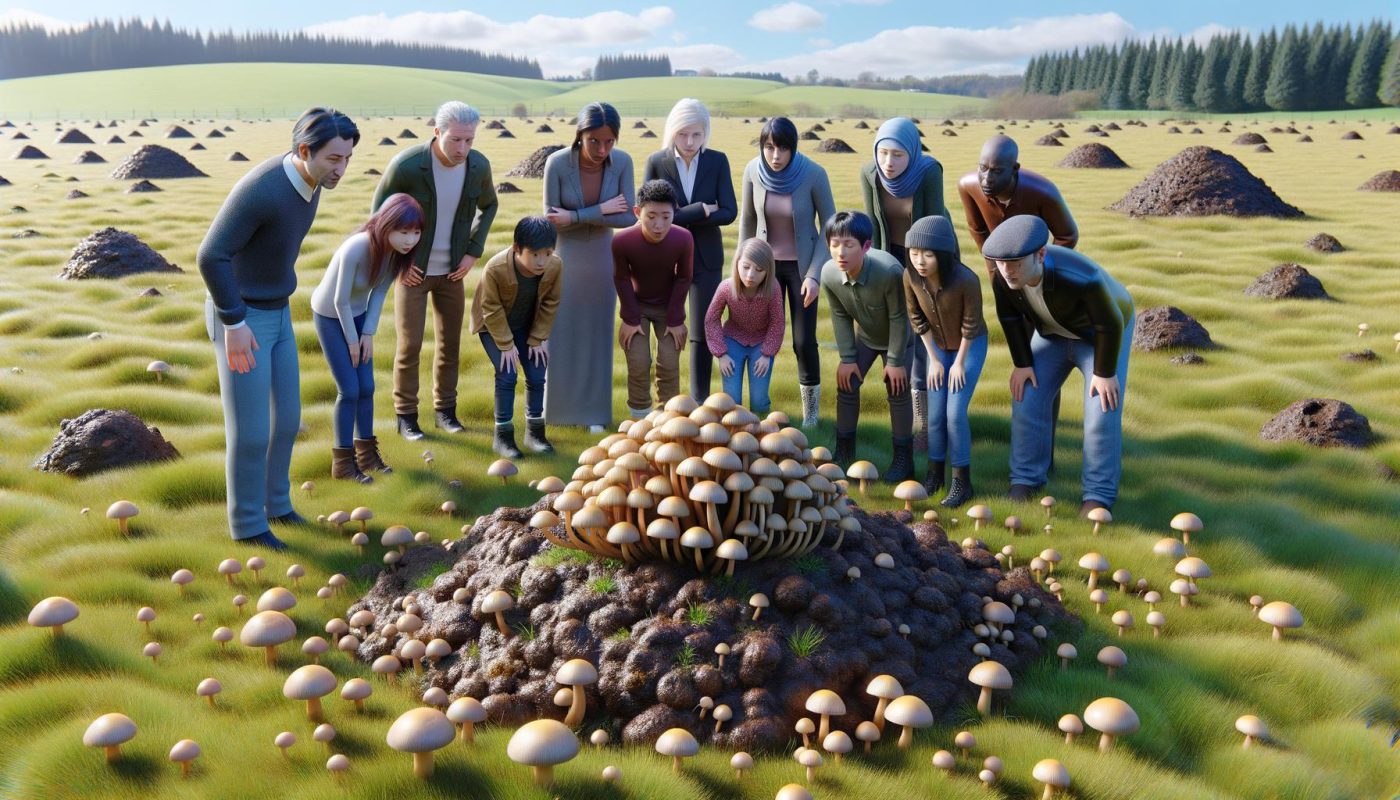Uncategorized
Do Psychedelic Mushrooms Grow in Horse Manure?
At Newphoria, we’re often asked about the fascinating world of psychedelic mushrooms. One common question that pops up is: do psychedelic mushrooms grow in horse manure?
This intriguing query touches on the unique relationship between certain fungi and animal waste. In this post, we’ll explore the natural habitats of psychedelic mushrooms and examine why horse manure might be an ideal substrate for their growth.
Where Do Psychedelic Mushrooms Grow Naturally?
Common Psychedelic Mushroom Species
Psychedelic mushrooms, known for their mind-altering effects, grow in diverse environments. Psilocybe cubensis stands out as the most well-known species. It thrives in tropical and subtropical regions, particularly in South and Central America, Southeast Asia, and parts of the United States. Another prevalent species, Psilocybe semilanceata (commonly called the liberty cap), grows in temperate climates across Europe and North America.
Natural Growing Environments
These fungi prefer nutrient-rich substrates. You’ll often find them in meadows, pastures, and forests where organic matter abounds. Psilocybe cubensis grows naturally on cow dung in places like Thailand and Cambodia. In contrast, Psilocybe azurescens (one of the most potent psychedelic mushrooms) is native to the Pacific Northwest of the United States and thrives in wood chips and sandy soils near coastal areas.
The Role of Organic Matter
Organic matter provides the essential nutrients and moisture for mycelium development and fruiting body formation. In nature, psychedelic mushrooms break down complex organic compounds, which plays a vital role in nutrient cycling within ecosystems.
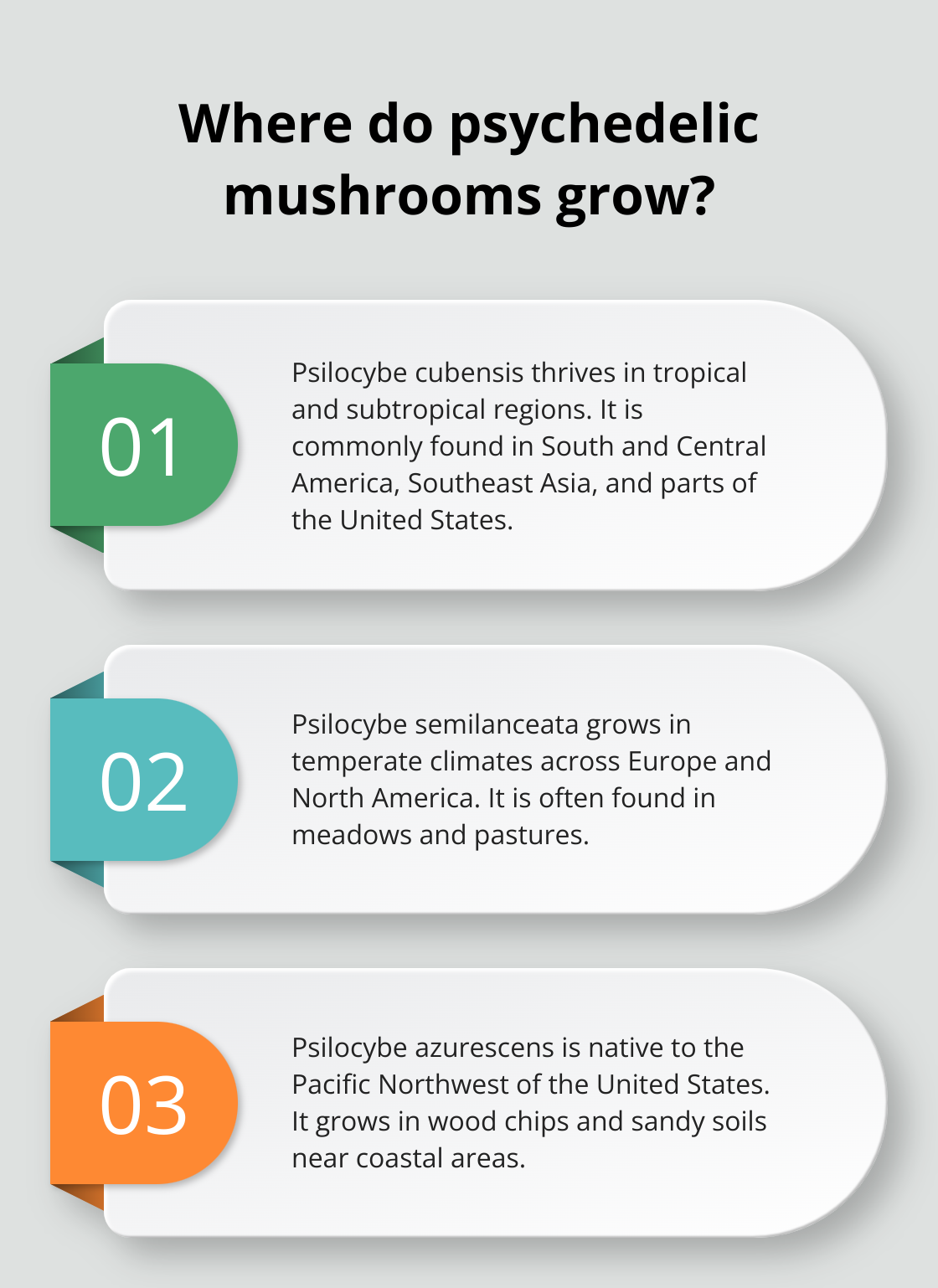
For example, Psilocybe cubensis mycelium colonizes horse and cow manure, breaking down cellulose and lignin. This process not only nourishes the mushroom but also enriches the soil, benefiting other plants in the ecosystem.
Conservation and Cultivation Implications
Understanding these natural habitats proves important for both conservation efforts and potential cultivation. However, foraging for wild psychedelic mushrooms can be extremely dangerous due to the risk of misidentification. Many mushroom species are toxic, and some can be fatal if ingested.
Safe Exploration Options
For those interested in exploring psychedelic mushrooms safely, lab-tested products offer a controlled alternative to wild foraging. Some wild mushrooms are poisonous and can cause serious harm, including death. It is important to only consume mushrooms that have been properly identified and sourced.
As we move forward, let’s explore a specific substrate that often supports the growth of psychedelic mushrooms: horse manure. This unique growing medium offers intriguing insights into the relationship between fungi and animal waste.
Why Is Horse Manure Ideal for Mushroom Growth?
Horse manure stands out as a preferred substrate for mushroom cultivators, including those who grow psychedelic varieties. Its unique composition and properties create an excellent medium for fungal growth.
Nutrient-Rich Composition
Horse manure contains essential nutrients that mushrooms need to thrive. The nitrogen content typically ranges from 35 percent to 60 percent of the total nitrogen, depending on how it’s spread and left on the soil surface. This nutrient profile creates an ideal environment for mushroom spores to germinate and for mycelium to spread.
Optimal Physical Structure
Horse manure provides an excellent physical structure for mushroom growth. As horses digest their food, the resulting manure retains partially broken-down plant material (primarily cellulose and lignin). This creates a porous structure that allows proper air circulation and water retention – two critical factors for successful mushroom cultivation.
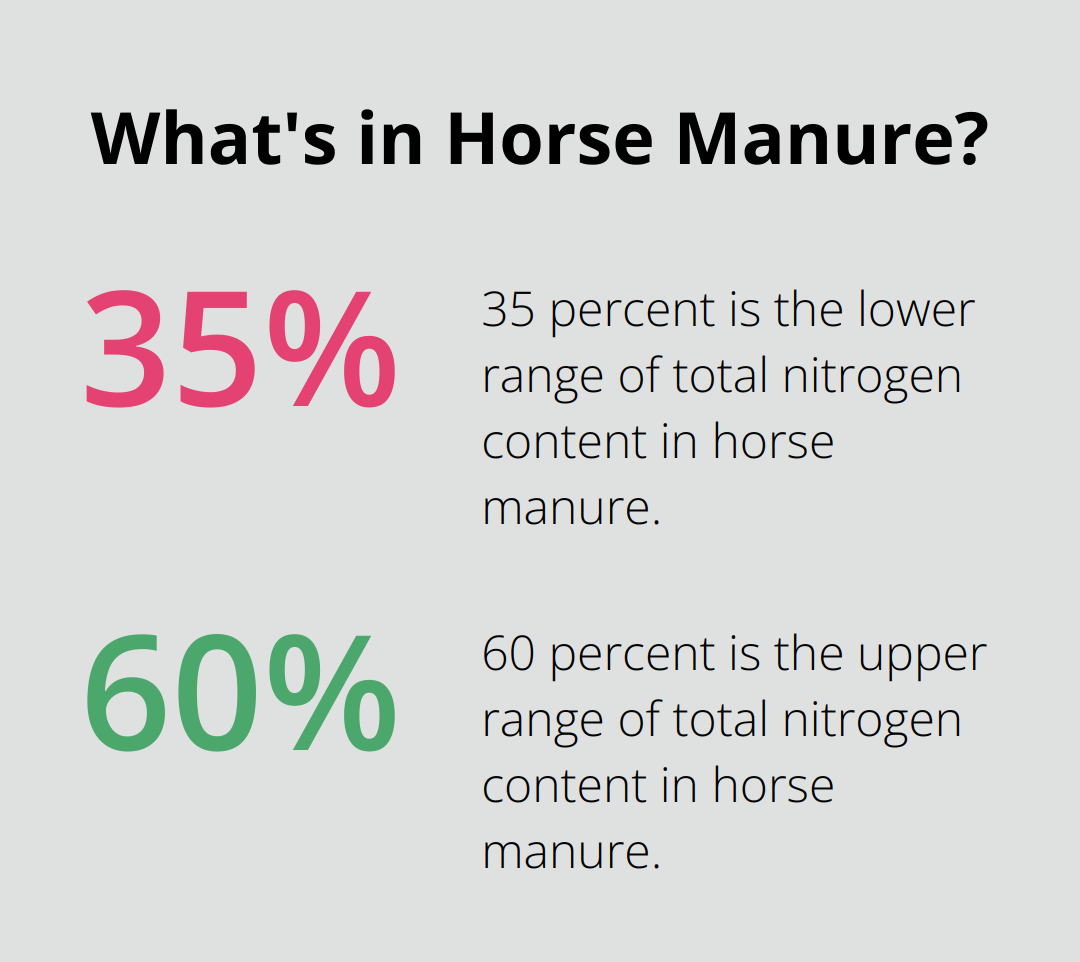
The texture of horse manure allows mycelium to penetrate and colonize the substrate easily. This benefits species like Psilocybe cubensis, which thrive in environments with good air exchange and moisture retention.
pH and Microbial Activity
Fresh horse manure typically has a pH between 7.5 and 8.5. As it ages and decomposes, the pH gradually lowers, creating a slightly acidic environment that many mushroom species prefer. This pH range also supports beneficial microbial activity, which can suppress harmful competitors and pathogens.
Horse manure is a good source of nutrients and a popular additive to many home gardens. It is highly valued by farmers for its microbial ecosystem, which can enhance mushroom growth. Certain bacteria and other microorganisms break down complex organic compounds into simpler forms that mushrooms can uptake more readily.
Comparison with Other Manures
While cow manure is also common for mushroom cultivation, horse manure often proves superior for several reasons. Horse manure tends to be less dense than cow manure, providing better aeration. It also typically contains more undigested plant material, offering a richer nutrient profile.
Chicken manure, while high in nitrogen, is often too “hot” (high in ammonia) for direct use in mushroom cultivation and requires extensive composting. Sheep and goat manures can be used but are less common due to their smaller pellet size and lower availability.
Horse manure-based substrates consistently produce high-quality mushrooms across various species. However, the use of any animal manure for mushroom cultivation requires proper handling and preparation to ensure safety and optimal growing conditions.
Now that we understand why horse manure serves as an excellent substrate for mushroom growth, let’s explore which specific psychedelic mushroom species thrive in this environment.
Which Psychedelic Mushrooms Thrive in Horse Manure?
Psychedelic mushrooms that grow in horse manure fascinate mycologists and enthusiasts alike. Their ability to thrive in this nutrient-rich substrate makes them a subject of interest. This chapter explores the species most commonly found in horse manure and their geographical distribution.
Psilocybe Cubensis: The Horse Manure Champion
Psilocybe cubensis stands out as the most prevalent psychedelic mushroom species found in horse manure. This species has a strong affinity for equine dung, making it a common sight in pastures and stables across tropical and subtropical regions. P. cubensis exhibits a distinctive golden-brown cap and blue bruising when handled (a telltale sign of its psychoactive properties).
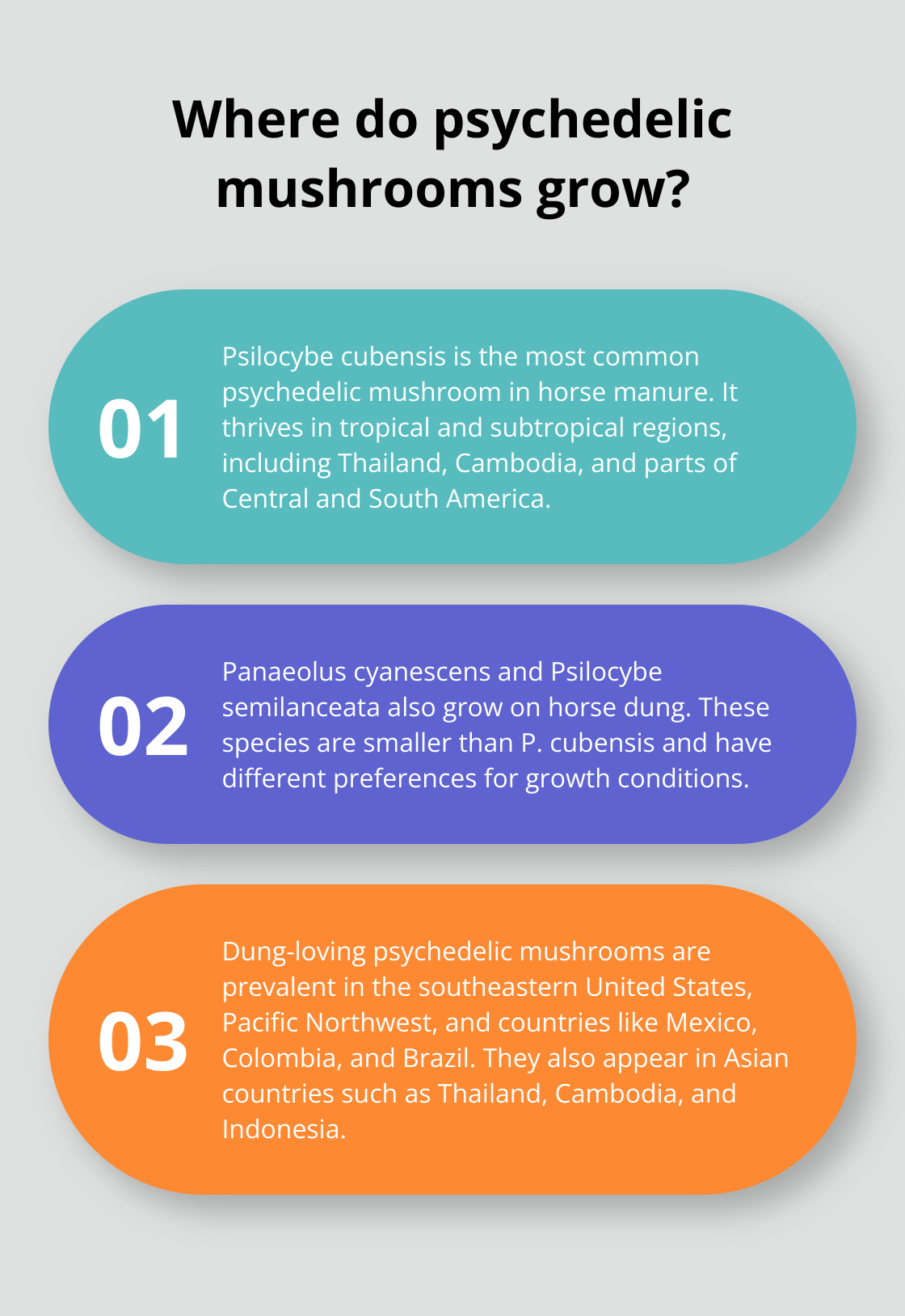
In the wild, P. cubensis fruits most abundantly during warm, humid periods following rainfall. Researchers have observed this species growing on horse manure in countries like Thailand, Cambodia, and parts of Central and South America. In the United States, it frequently appears in states with warm, humid climates such as Florida and Texas.
Other Dung-Loving Psychedelic Mushrooms
While P. cubensis takes the spotlight, several other psilocybin-containing mushrooms also grow on horse manure. Panaeolus cyanescens (often called Blue Meanies) is another species found on horse dung. This mushroom is smaller than P. cubensis.
Psilocybe semilanceata (commonly known as Liberty Caps) occasionally grows on well-rotted horse manure in pastures. However, this species prefers rich, grassland soils rather than directly on dung.
Geographical Distribution of Dung-Loving Psychedelics
The distribution of dung-loving psychedelic mushrooms largely follows the patterns of horse and cattle farming. In North America, these species appear most commonly in the southeastern United States (particularly in states like Florida, Georgia, and Texas). They also thrive in parts of the Pacific Northwest, where the climate provides ideal growing conditions.
In Central and South America, countries like Mexico, Colombia, and Brazil have reported significant populations of dung-loving psilocybin mushrooms. These regions’ warm, humid climates and extensive cattle ranching create perfect conditions for these fungi.
In Asia, countries like Thailand, Cambodia, and Indonesia serve as known hotspots for P. cubensis and other dung-loving psychedelic species. The traditional use of water buffalo in agriculture in these regions has contributed to the prevalence of these mushrooms.
Legal Considerations
The legal status of psychedelic mushrooms varies widely between countries and even between states or provinces within countries. Always check local laws and regulations regarding the possession, cultivation, or use of psychedelic mushrooms.
Safe Exploration Options
For those interested in exploring psychedelic mushrooms safely and legally, lab-tested products offer a controlled alternative to wild foraging. These products (including renowned strains like Penis Envy and Golden Teacher) provide both safety and quality assurance.
Final Thoughts
Psychedelic mushrooms do grow in horse manure, with Psilocybe cubensis showing a strong affinity for this substrate. However, foraging for wild mushrooms poses significant risks due to potential misidentification and legal issues. The legal status of psychedelic mushrooms varies widely across jurisdictions, making it essential to understand and comply with local laws.
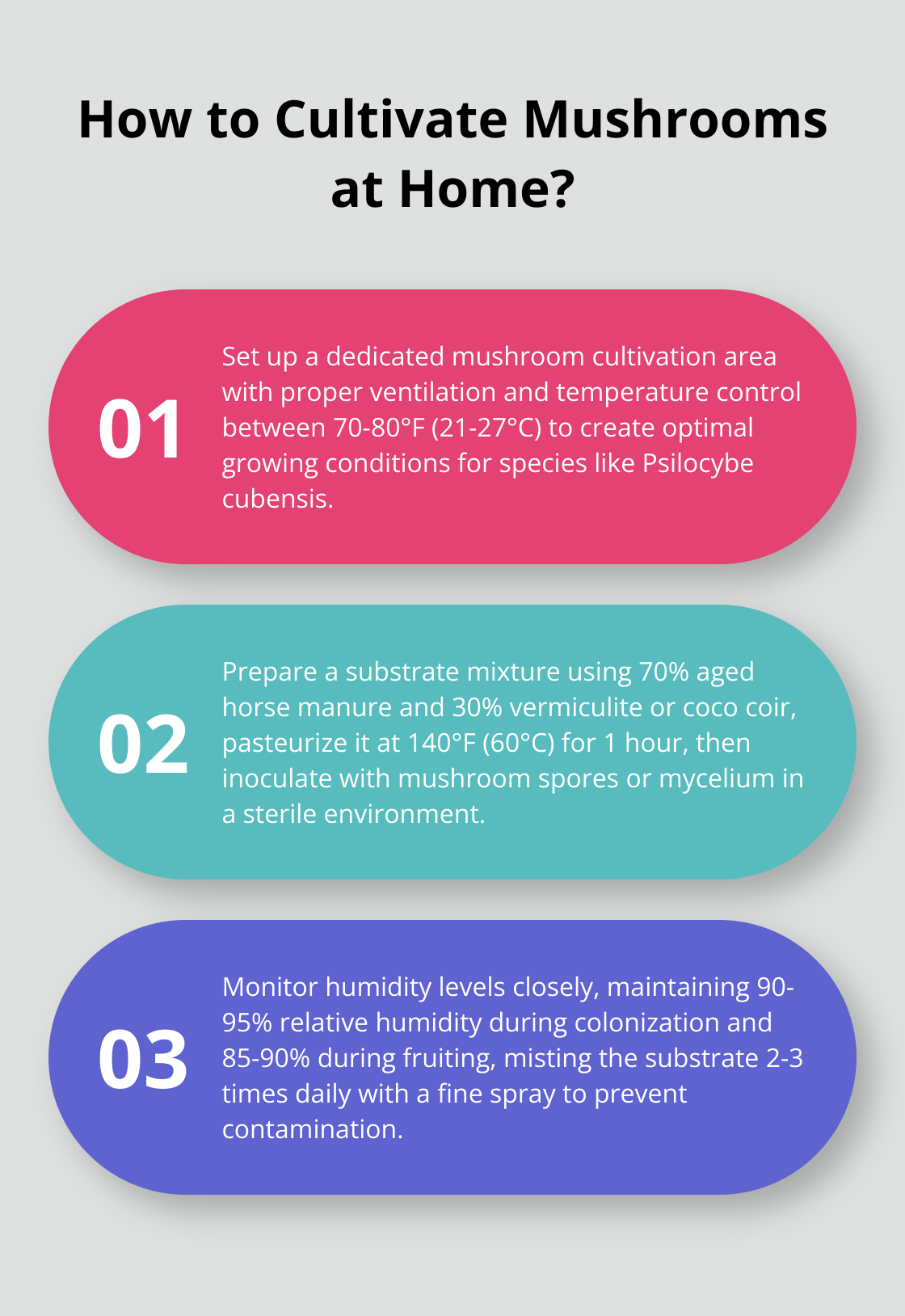
For those interested in exploring psychedelic mushrooms safely, Newphoria offers lab-tested products as an alternative to wild foraging. These products include renowned strains like Penis Envy and Golden Teacher, providing a controlled option for exploration. This approach allows individuals to experience potential benefits without the risks associated with misidentification or legal complications.
Research into the therapeutic potential of psychedelics continues to evolve. It’s important to approach this topic with respect for both the law and the powerful effects these substances can have. Always prioritize safety, legality, and ethical considerations in your journey with psychedelic mushrooms.

